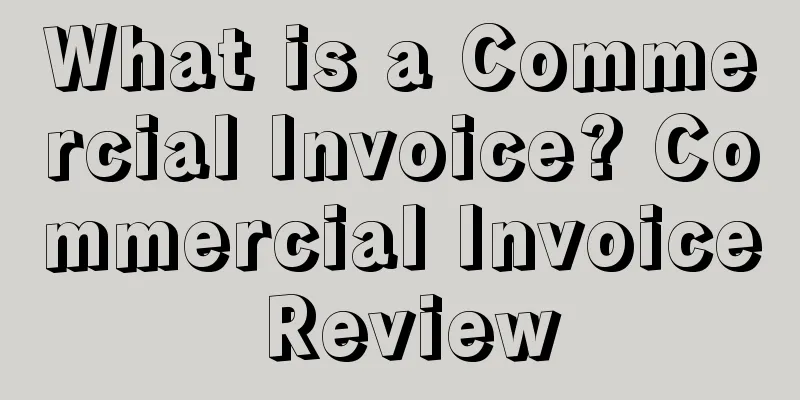What is a Commercial Invoice? Commercial Invoice Review

|
Commercial Invoice, also known as invoice in foreign trade, is a list of goods name, specifications, quantity, unit price, total amount, etc. issued by the export company to the foreign buyer. It is used by the foreign buyer to receive the goods, pay the goods and declare and pay taxes. It is a general description of the shipped goods, the basis for the importing country to determine the import tariff, and the basis for claims and compensation between the buyer and the seller. Although the invoice is not a certificate of property rights, if the invoice is missing from the export documents, the full situation of the business cannot be understood . 1. About Commercial Invoice The commercial invoice is the basis for the payment and accounting of the buyer and seller in the trade, and is one of the documents of international trade letters of credit. The commercial invoice is a comprehensive reflection of a business, including the name, specifications, price, quantity, amount, packaging, etc. of the goods. It is also an indispensable document for importers to handle import customs declarations. Therefore, the commercial invoice is the core of the full set of export documents. In the process of document preparation, the rest of the documents must be prepared with reference to the commercial invoice. Generally, the word "INVOICE" is printed on invoices without any modifier in front of it. For example, if the letter of credit stipulates the use of "COMMERCIAL INVOICE", "SHIPPING INVOICE", "TRADE INVOICE" or "INVOICE", they can all be understood as commercial invoices. 2. Content Description 1. Name and address of the bill maker: The seller column should be filled in with the full name and address according to the provisions of the contract and letter of credit. Generally, the name and address should be printed in separate lines. 2. Name and address of the consignee's company: The buyer column is also called the consignee or payee of the invoice. When payment is made by letter of credit, the commercial invoice must be made payee of the letter of credit applicant, unless otherwise specified in the letter of credit. For documentary collection business, the consignee on the invoice should be prepared according to the buyer or designated name listed in the contract, and the detailed address should be listed. 3. Invoice number: The invoice number is compiled by the exporter. On the one hand, it is convenient for the exporter to search, and on the other hand, it represents the number of the whole set of documents and a batch of goods. Therefore, it cannot be omitted when preparing the invoice. For example, the number when preparing the bill of exchange is filled in according to the invoice number. 4. Invoice Date: The date of issue of the invoice. In the case of a letter of credit, it is usually after the letter of credit opening date and before the shipment date, or at least before the presentation of documents or the expiration date. 5. Letter of credit number: Fill in according to the letter of credit. 6. Date of letter of credit: fill in according to the letter of credit. 7. Issuing Bank: Fill in the issuing bank of the letter of credit. 8. Contract number: It should be consistent with that listed on the letter of credit and must be listed on the invoice. If a transaction has several contract numbers, they should all be printed on the invoice. 9. Contract Date: the time when the contract is concluded. 10. Place of Departure: Fill in according to the provisions of the letter of credit and be consistent with that listed on the bill of lading. 11. Destination: Fill in according to the letter of credit. At the same time, please note that the destination regulations must be clear and specific, not vague; if there is a duplicate destination, the country name must be added after it. 12. Means of transport: After receiving the loading notice from the shipping company or transport agent, list the means of transport and voyage according to the loading content. 13. Marks: All marks specified in the letter of credit must be drawn up word for word and line by line in accordance with the regulations and must be consistent with the marks on other documents. If there are no marks specified in the letter of credit, the marks specified in the contract terms or the marks provided by the buyer shall be drawn up; if there are no regulations, the seller shall design them on his own and ensure that they are consistent with the documents. 14. Product name and specifications: must be consistent with the contract and letter of credit. If the order is made under a letter of credit, special attention should be paid to the following points: (1) The product name on the invoice cannot exceed the content of the letter of credit. (2) The name of the goods cannot be omitted or shortened at will. If the name of the goods in the certificate is detailed and specific, it should be copied. (3) The Chinese and foreign language product names must be written correctly. (4) If the name of the product in the letter of credit is wrong, if it is a substantive issue, it should be modified in time. If it is a minor issue, you can copy it and add brackets, but strictly speaking, this is also a discrepancy between the documents and the credit, and it is better to modify the letter of credit. (5) The specifications required by the certificate must be fully reflected in the document. 15. Quantity or weight: It must be consistent with the actual shipment and the provisions of the letter of credit. For goods priced by piece, the invoice must list the number of pieces; for goods priced by weight, the weight must be listed. If there are many specifications of goods, the subtotal quantity of each product should be indicated, and the total quantity should be indicated at the end. 16. Price terms: They must be filled in strictly according to the provisions of the letter of credit. Sometimes they include commissions, and sometimes they do not. 17. Unit price and total value: These are the key points of the invoice. Special attention should be paid to the fact that the invoice amount should not exceed the letter of credit amount, and the currency of the invoice should be consistent with that of the letter of credit. 18. Issuer and signature: Generally, an invoice must be signed and sealed by the exporter to be valid. Please make sure that the seal and signature used are consistent with the seals and signatures on other documents. If the other country requires a handwritten signature, please pay attention to the customs of each country. Note: In actual business, it is common to have multiple item numbers in one invoice, which requires that the format of the invoice be neat. The content and total of each item number should be arranged in order, with the content of each item number in the horizontal row and the total of each item number in the vertical row. 3. Sample 4. Function 1. It allows importers to understand and grasp the comprehensive situation of the shipped goods. 2. Serves as the basis for importers’ accounting, import declaration, customs statistics and customs tax payment. 3. The exporter records each item in the account based on the contents of the invoice. Before the goods are shipped, the exporter needs to submit a commercial invoice to the customs as a customs declaration invoice. The customs uses it to calculate taxes and as one of the vouchers for customs clearance and statistics. 4. In the absence of a bill of exchange, an invoice can replace a bill of exchange as a basis for payment; in addition, once an insurance claim occurs, the invoice can be used as proof of the value of the goods. V. Form There is no unified format for commercial invoices. Each company that issues commercial invoices has its own invoice format. Although the formats are different, the items filled in the commercial invoice are similar. Generally speaking, a commercial invoice should have the following main contents: 1. The first part: The first part should list the name of the invoice, invoice number, contract number, invoice date and place, as well as the name of the ship, port of loading, port of discharge, consignor, consignee, etc. This part is usually printed, and the blank space left behind must be filled in. 2. Text part: The text of the invoice mainly includes the mark, product name, quantity of goods, specifications, unit price, total price, gross weight/net weight, etc. 3. Closing part: The closing part of the invoice generally includes the special terms or sentences added in the letter of credit. The closing part of the invoice also includes the signature of the issuer of the invoice. The signature of the issuer of the invoice is generally in the lower right corner of the invoice, and generally includes two parts: one is the name of the exporter (beneficiary of the letter of credit), and the other is the handwritten signature of the manager of the export company or other authorized persons, and sometimes a handwritten stamp is used instead of a handwritten signature. 6. Identify authenticity 1. Review the invoice format: There are different invoice formats for different periods. If you find that an old version of the invoice is used for reimbursement after the expiration date, you should find out the reason to see if there is any problem. You should check whether the invoice is printed clearly, whether there are any errors or omissions, and distinguish the authenticity. 2. Check the handwriting on the invoice: Check the handwriting, style, strokes and indentation of the invoice photo, date, product name, quantity, unit price and uppercase and lowercase amounts. Check whether there are any traces of fading, eraser or knife scraping. 3. Check the carbon copy of the invoice: Check whether the color of the carbon copy is the same. Check the front and back of the invoice carefully to see whether the carbon copy is in accordance with the actual situation and whether there are any traces of partial carbon copy on the back. If the second copy of the invoice is not carbon copy but filled in with a fountain pen or ballpoint pen, it means there is a problem. 4. Check the displacement of invoice filling: When the enterprises designated by the tax authorities print and bind invoices, the vertical and horizontal rows of each copy are aligned and have fixed positions. If there is abnormal displacement of the handwriting on each copy of the invoice, there may be a problem. 5. Review the contents of the invoice: check whether the time, photo, unit price, quantity and amount of the invoice reimbursement copy are complete; check whether the names of the items on the invoice are specific, correct and clear. For example, if the category names written are production supplies, office supplies, electrical appliances, department stores, daily necessities, local products, and the amount is large, there may be problems in this case regardless of whether the payment is in cash or by transfer check. 6. Check the invoice distribution scope: For example, if the invoice of a home appliance repair department or a processing store shows that the item is coal, there is obviously a problem. 7. Check whether the name of the invoice unit is consistent with the name of the shipping unit and the receiving unit. 8. Check whether the purchasing unit written on the invoice is consistent with the name of the actual receiving unit and paying unit. 9. Check whether the same supplier, especially individual business owners, uses invoices from different units. 10. Check the invoice numbers. Check whether the invoices of the same unit are reimbursed multiple times in a certain unit, but the invoice numbers are connected in sequence and the time is reversed. References |
<<: What is TUV certification? TUV certification review
>>: What is Wish Yellow Diamond? Wish Yellow Diamond Review
Recommend
Walmart Review Benchmark Report 2023: 10 major categories
It is learned that recently, the review analysis ...
Can Chinese sellers be exempted from VAT? The platform confirmed
Some time ago, sellers in the United States recei...
American consumers regard YouTube as the most trusted social e-commerce platform!
<span data-docs-delta="[[20,"美国消费者将YouTube...
Trump is stable! Brother-in-law angrily blocked 10,000+ accounts! A large number of sellers were linked!
The much-anticipated US presidential election has ...
FBA policy changes again? Defect rate over 50% will be banned for 30 days!
Normal, once there is data abnormality, such as s...
Product recall rate in the U.S. hits a 10-year high! Focus on five major categories
It is learned that on June 1, Sedgwick Brand Prote...
Target released its Q3 financial report for 24 years, with revenue increasing slightly by 1.1% to US$25.7 billion
It is learned that on November 20, the US retail g...
Amazon has added a new fee, effective June 1st!
Not long ago, Amazon released its first quarter fi...
What is Klear? Klear Review
Klear (formerly Twtrland) is an influencer marketi...
What is an export tax rebate letter? Export tax rebate letter inquiry review
Tax refund letter inquiry is a way for the tax bur...
What is Tenghui Electronics? Tenghui Electronics Review
Shenzhen Tenghui E-commerce Co., Ltd. is a cross-b...
How to do a good job in Amazon's off-site promotion
To do a good job of off-site promotion on Amazon, ...
Essential work before launching Amazon CPC advertising
Amazon’s advertising performance will be affected ...
What is Shiding Shield? Shiding Shield Review
"Shiding Shield" is an intellectual prop...
What is the IRS? Review of the IRS
The Internal Revenue Service (IRS) is a taxation a...









